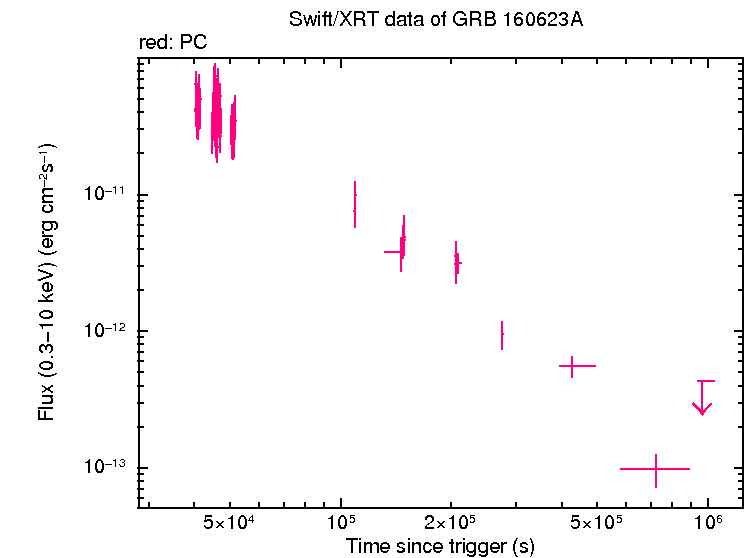
A. Tiengo (IUSS Pavia), B. Mingo (U. Leicester) and A. Breeveld (UCL-MSSL) for the Swift team
Tiengo et al. (GCN Circ. 19559) reported the initial Swift results. Table 1 contains the best reported positions from Swift.
Pozanenko et al. (GCN Circ. 19561) reported the position from Mondy for the optical afterglow of this GRB. Malesani et al. (GCN Circ. 19708) determined a redshift of 0.367, and Castro-Tirado et al. (GCN Circ. 19710) determined a redshift of 0.367 from GTC. Table 2 is a summary of GCN Circulars about this GRB from observatories other than Swift.
BAT refined results are not available.
XRT refined results are not available.
The Swift/UVOT began settled observations
(Breeveld and Maselli GCN Circ. 19568) of the field of GRB 160623A 40254 s after the LAT trigger (Vianello et al., GCN Circ. 19553).
No optical afterglow consistent with the XRT position (Mingo et al. GCN Circ. 19558) or the Mondy and RATIR position (Pozanenko et al. GCN Circ. 19561; Butler et al. GCN Circ. 19567) is detected in the initial UVOT exposures.
Table 3 gives preliminary
magnitudes using the UVOT photometric system
(Breeveld et al. 2011, AIP Conf. Proc., 1358, 373).
No correction has been made for the expected extinction in the Milky Way
corresponding to a reddening of
Figure 1. The BAT light curve is not available.

Figure 2. The XRT light curve.
Any data from a crosshatched region are not included in the fit.
| RA (J2000) | Dec (J2000) | Error | Note | Reference |
|---|---|---|---|---|
| 2 |
+42°13'15.4" | 1.5" | XRT-final | UKSSDC |
| 2 |
+42°13'13.7" | 3.5" | XRT | Mingo et al. GCN Circ. 19558 |
| Band | Authors | GCN Circ. | Subject | Observatory | Notes |
|---|---|---|---|---|---|
| Optical | Pozanenko et al. | 19561 | Mondy optical observations | Mondy | light curve |
| Optical | Butler et al. | 19567 | RATIR Optical and NIR Observations, Afterglow Confirmation |
RATIR | detection |
| Optical | Kuroda et al. | 19572 | MITSuME Ishigakijima Optical Observation | MITSuME Ishigakijima | detection |
| Optical | Mazaeva et al. | 19574 | TSHAO optical observations | Zeiss-1000 | detection |
| Optical | Moskvitin | 19614 | SAO RAS optical observations | SAO RAS | |
| Optical | Malesani et al. | 19708 | optical astrometry, photometry, and redshift |
RATIR | redshift |
| Optical | Castro-Tirado et al. | 19710 | afterglow spectroscopy by GTC and independent redshift determination |
GTC | spectroscopy |
| Radio | Urata et al. | 19584 | SMA submm afterglow observations | SMA | |
| Radio | Mooley et al. | 19609 | Possible detection of a radio afterglow at 15 GHz with AMI |
AMI | possible detection |
| Radio | Nayana et al. | 19848 | Possible radio detection of GRB160623A with the GMRT |
GMRT | possible detection |
| Gamma-ray | Vianello et al. | 19553 | Galactic transient: Fermi-LAT detection | Fermi LAT | |
| Gamma-ray | Frederiks et al. | 19554 | Konus-Wind observation | Konus-Wind | Fluence=6.6(-0.1,+0.1)x1 |
| Gamma-ray | Mailyan et al. | 19555 | Fermi GBM detection/observation | Fermi GBM | Fluence=5.598±0.369x1 |
| Gamma-ray | Yamaoka et al. | 19597 | CALET Gamma-Ray Burst Monitor detection | CALET |
| Filter | Exp(s) | Mag | ||
|---|---|---|---|---|
| v | 40657 | 51652 | 2859 | >21.1 |
| u | 40254 | 51253 | 2008 | >21.5 |
Table 3. UVOT observations reported by Breeveld and Maselli (GCN Circ. 19568). The start and stop times of the exposures are given in seconds since the BAT trigger. The preliminary 3-σ upper limits are given. No correction has been made for extinction in the Milky Way.
August 24, 2016